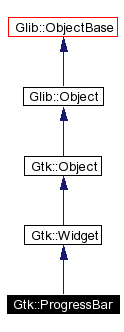
 |
Gtk::ProgressBar Class Reference
[Widgets]
A widget which indicates progress visually.
More...
Inheritance diagram for Gtk::ProgressBar:

Public Methods | |
| virtual | ~ProgressBar () |
| GtkProgressBar* | gobj () |
| const GtkProgressBar* | gobj () const |
| ProgressBar () | |
| void | pulse () |
| Indicates that some progress is made, but you don't know how much. | |
| Glib::ustring | get_text () const |
Retrieves the text displayed superimposed on the progress bar, if any, otherwise 0. | |
| void | set_text (const Glib::ustring& text) |
| Causes the given text to appear superimposed on the progress bar. | |
| double | get_fraction () const |
| Returns the current fraction of the task that's been completed. | |
| void | set_fraction (double fraction) |
| Causes the progress bar to "fill in" the given fraction of the bar. | |
| double | get_pulse_step () const |
| Retrieves the pulse step set with set_pulse_step(). | |
| void | set_pulse_step (double fraction) |
| Sets the fraction of total progress bar length to move the bouncing block for each call to pulse(). | |
| void | set_orientation (ProgressBarOrientation orientation=PROGRESS_LEFT_TO_RIGHT) |
| Causes the progress bar to switch to a different orientation (left-to-right, right-to-left, top-to-bottom, or bottom-to-top). | |
| ProgressBarOrientation | get_orientation () const |
| Retrieves the current progress bar orientation. | |
| Glib::PropertyProxy<double> | property_fraction () |
| Glib::PropertyProxy<double> | property_pulse_step () |
| Glib::PropertyProxy<ProgressBarOrientation> | property_orientation () |
| Glib::PropertyProxy<Glib::ustring> | property_text () |
Related Functions | |
| (Note that these are not member functions.) | |
| Gtk::ProgressBar* | wrap (GtkProgressBar* object, bool take_copy=false) |
Detailed Description
A widget which indicates progress visually.The Gtk::ProgressBar is typically used to display the progress of a long running operation. It provides a visual clue that processing is underway. The Gtk::ProgressBar can be used in two different modes: percentage mode and activity mode.
When an application can determine how much work needs to take place (e.g. read a fixed number of bytes from a file) and can monitor its progress, it can use the Gtk::ProgressBar in percentage mode and the user sees a growing bar indicating the percentage of the work that has been completed. In this mode, the application is required to call set_fraction() periodically to update the progress bar.
When an application has no accurate way of knowing the amount of work to do, it can use the Gtk::ProgressBar in activity mode, which shows activity by a block moving back and forth within the progress area. In this mode, the application is required to call pulse() perodically to update the progress bar.
There is quite a bit of flexibility provided to control the appearance of the Gtk::ProgressBar. Functions are provided to control the orientation of the bar, optional text can be displayed along with the bar, and the step size used in activity mode can be set.
Constructor & Destructor Documentation
|
|
|
|
|
|
Member Function Documentation
|
|
Returns the current fraction of the task that's been completed.
|
|
|
Retrieves the current progress bar orientation.
|
|
|
Retrieves the pulse step set with set_pulse_step().
|
|
|
Retrieves the text displayed superimposed on the progress bar, if any, otherwise The return value is a reference to the text, not a copy of it, so will become invalid if you change the text in the progress bar.
|
|
|
Reimplemented from Gtk::Widget. |
|
|
Reimplemented from Gtk::Widget. |
|
|
|
|
|
|
|
|
|
|
|
|
|
|
Indicates that some progress is made, but you don't know how much. Causes the progress bar to enter "activity mode," where a block bounces back and forth. Each call to pulse() causes the block to move by a little bit (the amount of movement per pulse is determined by set_pulse_step()). |
|
|
Causes the progress bar to "fill in" the given fraction of the bar. The fraction should be between 0.0 and 1.0, inclusive.
|
|
|
Causes the progress bar to switch to a different orientation (left-to-right, right-to-left, top-to-bottom, or bottom-to-top).
|
|
|
Sets the fraction of total progress bar length to move the bouncing block for each call to pulse().
|
|
|
Causes the given text to appear superimposed on the progress bar.
|
Friends And Related Function Documentation
|
||||||||||||
|
|
The documentation for this class was generated from the following file:
Generated for gtkmm by Doxygen 1.3-rc1 © 1997-2001